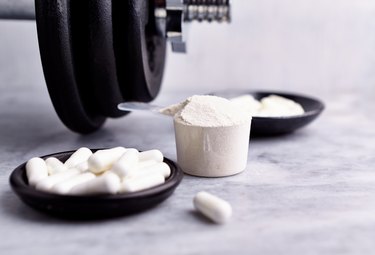
If you're prepping for a bodybuilding competition, you might wonder if you should continue to take your supplements. Cutting, a common practice among fitness competitors and bodybuilders, involves restricting calorie intake to cut fat so that you look as lean as possible on competition day.
Many bodybuilders take dietary supplements, including creatine, during the cutting phase. The way you take creatine during cutting is slightly different from when you're bulking. Consult with your sports physician and training coach before taking dietary supplements such as creatine.
Video of the Day
Video of the Day
Tip
Taking a maintenance dose of creatine during a cutting phase can help you retain lean muscle mass while losing fat.
Boost Your Energy
Creatine is an amino acid naturally produced by the body and also found in protein-rich foods such as meat and fish. It plays a role in producing energy during weightlifting and other types of short-duration, high-intensity exercise.
Creatine serves as a precursor to adenosine triphosphate, or ATP, a crucial energy source for the body — especially working muscles. For this reason, it's commonly taken as a pre-workout supplement to boost workout performance. It may also increase lean mass.
Read more: What Is the Minimum Age for Taking Creatine?
Creatine While Cutting
Although the goal during the cutting phase is to lose fat, you will inevitably lose some muscle as well. Creatine can help you maintain lean mass while cutting because it makes the body burn energy more efficiently, according to fitness author Sean Nalewanyj. Supplementing with creatine also increases your resting metabolic rate, or the amount of energy your body burns at rest.
Avoid the Bloat
Some bodybuilders have reservations about taking creatine during a cutting phase because it draws water into the muscles, which may cause you to look bloated. The amount of water gained is dependent on your creatine dose — the higher the dose, the more water the muscles take in.
According to a 2017 study published by Journal of the International Society of Sports Nutrition, the average adult needs one to three grams of creatine daily to maintain muscle mass. However, individuals with a higher amount of muscle, engaged in high-intensity training often need five to 10 grams per day to maintain lean muscle.
Although creatine can cause muscles to retain water, carbohydrate intake typically decreases while you're in a calorie deficit, which can make your muscles lose water and look smaller. Continuing to supplement with creatine while cutting can help your muscles appear fuller.
Other Benefits of Creatine
In addition to increased energy, research has suggested that creatine might promote faster recovery and decrease muscle damage by reducing inflammation after high intensity training.
Be Aware of Side Effects
Only take supplements if you're healthy and you've discussed it with your doctor. If you're new to creatine, you may experience negative side effects such as nausea, diarrhea or stomach upset. These side effects are generally mild and tend to go away with continued use.
Creatine may cause an increase in blood pressure in certain people, so talk to your doctor if you have hypertension or are at risk for it. Tell your doctor about any medications you take, as creatine may interact with certain drugs.
Read more: 10 Things to Avoid When Taking Creatine
- Journal of the International Society of Sports Nutrition: The Effects of Pre Versus Post Workout Supplementation of Creatine Monohydrate on Body Composition and Strength
- Sean Nalewanyj: Should You Use Creatine While Cutting?
- Mayo Clinic: Creatine
- Journal of the International Society of Sports Nutrition: International Society of Sports Nutrition Position Stand: Safety and Efficacy of Creatine Supplementation in Exercise, Sport, and Medicine